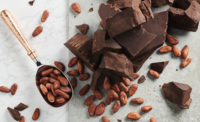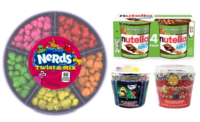It’s telling that the Pantone 2021 Color of the Year isn’t one color — it’s two. Gray and yellow. Or, well, officially, “Ultimate Gray and Illuminating.”
The pair so perfectly captures the complicated current mood: A unique mix of sadness and hope that would be impossible to describe to the 2019 versions of ourselves.
The world feels gray. The world feels yellow. We all feel both.
It’s a dichotomy that’s impacted food trends as well. Consumers are sad and shell-shocked, so they want indulgent comfort foods. But consumers are also hopeful and focused on the future, so they want exciting healthy options.
“The pandemic has had various impacts on consumer behavior,” explains Rebeka Davis, account manager, GNT USA. “On the one hand, many people have been indulging more in chocolate and sugar confectionery; on the other, eight in ten worldwide say they plan to adopt healthier eating and drinking habits.”
Emina Goodman, senior director, colors, ADM, says the juxtaposition has made for some interesting trend predictions.
“Our color forecasts show that soothing, neutral colors will be paired with comforting flavors like chocolate, vanilla, caramel, nutmeg and coffee, while blues and purples will be matched with botanicals like lavender and chamomile,” Goodman said. “Bright, energy-boosting colors will also be popular this year as consumers seek products that signal happiness. Using colors that create feelings of optimism and excitement can give consumers a positive eating experience.”
She said Pantone’s Illuminating Yellow can help in this regard when it comes to candy, as it can be used to spark feelings of energy and joy.
“Consumers are also gravitating toward candy and confections to boost mood and improve mental health,” Goodman said. “ADM Outside Voice research finds 35 percent of consumers are concerned about mental health, and 84 percent see mental health as being equally important as physical well-being. Consumers are seeking comforting experiences to relieve stress and anxiety associated with the ongoing COVID-19 pandemic.”
Natural colors continue to gain popularity
Looking beyond the colors themselves, a lot of shoppers are looking for clean labels, as they seek out products with close-to-nature ingredient labels and better-for-you properties.
“There is a continued color conversion from artificial to natural colors in the confection industry,” Goodman said. “We see that consumers are looking for confections that use natural color sources, such as botanicals, fruit and vegetable juices, spices, beta carotene and more. Product developers can account for this shift by incorporating plant-forward, natural ingredients as color sources, such as bright spices like turmeric or various fruit juices.”
A number of brands continue to highlight their use of natural colors. For example, Project 7’s new Sour Apple Rings and Sour Gummy Worms are made without artificial colors. And, Welch’s brand new Juicefuls Fruit Snacks are also made with natural colors.
“Parents can feel good about serving them, while the entire family will equally enjoy Juicefuls,” said Nicole Luisi, brand manager for The Promotion In Motion Companies, Inc.
However, going back to the Gray and Yellow juxtaposition of what consumers are asking for, while they may want natural options, they aren’t ready to give up artificial hues completely.
In January Mars said it would continue to use artificial colors in its product lines, which include brands like Skittles and Starburst. The company had initially announced plans in 2016 to “remove all artificial colors from its human food products as part of a commitment to meet evolving consumer preferences.”
However, in January 2021 Mars said a majority of its U.S. consumers “appreciate the current vibrant palette used in their favorite treats. So, Mars will not remove all artificial colors from the entire portfolio...This approach is consistent with intent to meet evolving consumer preferences and more information can be found on mars.com.”
The decision from Mars highlights the difficulty in finding vibrant natural colors for confectionery. But suppliers continue to innovate on bright natural color options for candy makers looking to make the switch without sacrificing brightness.
For example, ADM’s fruit juice blue is created using the huito fruit from Peru’s Amazon region, and it can help produce a full spectrum of natural colors that can be used in a wide variety of applications and deliver on a clean label.
In addition, GNT’s EXBERRY colors also offers another option. EXBERRY colors are suitable for almost any confectionery application and GNT can provide shades covering the whole rainbow. And they are made from edible fruit, vegetables and plants with no chemical solvents.
“That means they can be described on the label as ‘fruit and/or vegetable juice (color)’ or ‘spirulina extract (color),’ which is easy for shoppers to understand and provides instant reassurance,” Davis said.
GNT recently launched a new red potato-based color that can help to deliver a bright red color for candy with flavors such as strawberry.
“It’s well known that confectionery manufacturers have been moving away from artificial colors for some time, but even so-called natural colors can risk alienating consumers. Carmine, for example, is a commonly used 'natural' red made from insects,” Davis said. “Using plant-based colors can make candy more attractive in every sense. They can not only be used to achieve a range of vibrant shades, but nearly two-thirds (63 percent) worldwide say they find coloring in the form of concentrated juice from fruits, vegetables or plants appealing.”
A year of constant health-related news also has inspired consumers to focus on building immunity. But how does that relate to colors?
“We’re increasingly providing coloring solutions for confectionery products with health benefits such as vitamin gummies and pressed tablets,” Davis said. “Plant-based colors are the obvious choice for functional candy because they can deliver vibrant shades in most applications while maintaining the ‘clean’ ingredient lists that health-conscious consumers demand.”
Formulating with new colors innovations
So how can candy makers formulate with updated colors, including natural and plant-based options?
Davis said it’s important to first understand your consumer market, asking questions like: Is the product an occasional indulgence or a product they will consume more frequently? Can plant-based colors increase the consumer sector that purchases the product or the frequency with which they will eat it?
Once a candy maker decides to use new color options, they can usually work with specialists at suppliers on the specifics.
“The confectionery space often presents formulation challenges, like heat, pH, packaging, color interactions, shelf life and taste, that can restrict specific color usage,” Goodman said.
And when it comes to natural colors specifically, stability is a critical factor.
“Delicate candies and beautifully crafted chocolates must have a lovely appearance that complements their rich flavors,” Goodman said. “ADM’s patented emulsion system delivers heat, light and acid-stable colors that do not bleed or migrate into each other, which is incredibly important when working with bright, swirled hard candies. Plus, our emulsion technology keeps colors stable without opacity during expected shelf life.”
The company’s patented acid- and heat-stable fruit juice blue also helps formulators expand their confections’ colors into new shades beyond the standard yellow, orange and red.
“When combined with other fruits or vegetables, our fruit juice blue can provide a full rainbow of bold, eye-catching and stable natural shades, ranging from blues to purples to greens and even a brown shade that is caramel free,” Goodman said.
As for GNT, its product line contains the full range of color hues, which work well in most confectionery applications. And their sales team is trained with a technical background to help candy makers choose the best color options based on their project needs.
The company’s lab in New York can also help with color matching or prototype development to create specific recommendations for every project.
If the future is going to be bright, it may need to help getting there. And the candy industry, which knows firsthand how much color impacts our perceptions of the world, may be just who we need to do it.








